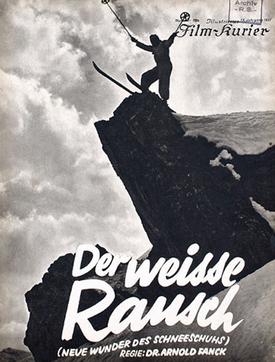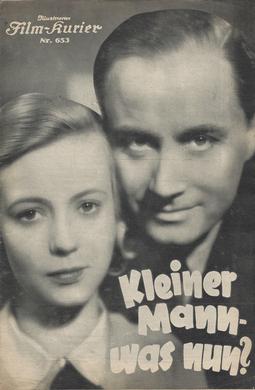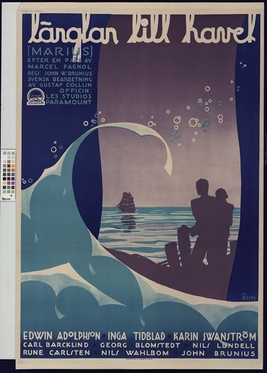Erik Aaes was a Danish set designer and art director. He was a prominent figure behind the scenes of Scandinavian theatre and in film.
George Tzavellas, also rendered Giorgos Tzavellas, Yiorgos Tzavellas, or Yorgos Javellas, was a Greek film director, screenwriter, and playwright. His filmmaking was particularly influential, with critic Georges Sadoul considering him "one of the three major postwar Greek directors".

The White Ecstasy is a 1931 German mountain film written and directed by Arnold Fanck and starring Hannes Schneider, Leni Riefenstahl, Guzzi Lantschner, and Walter Riml. The film is about the skiing exploits of a young village girl, and her attempts to master the sport of skiing and ski-jumping aided by the local ski expert. Filmed on location in Sankt Anton am Arlberg, the film was one of the first to use and develop outdoor film-making techniques and featured several innovative action-skiing scenes.
Gennady Myasnikov was a Soviet production designer. He was nominated for an Academy Award for Best Art Direction for his work on the epic film War and Peace (1967). He was born in Sosnovka.
Agradoot was a group of Indian film technicians signing collectively as director, a phenomenon unique to Bengali cinema. The Agradoot core unit, formed in 1946, consisted initially of Bibhuti Laha, Jatin Datta (sound), Sailen Ghosal, Nitai Bhattacharya (scenarist) and Bimal Ghosh (production). The group was active up to the end of 1980s.
Huma Gun Anmogaldi is a Bollywood film directed by Mehboob Khan. It was released in 1942.

Veriko (Vera) Ivlianovna Anjaparidze was a Soviet and Georgian stage and film actress.

Lulu is a 1962 Austrian crime drama film written and directed by Rolf Thiele. The film is an adaptation of Frank Wedekind's Lulu plays—Earth Spirit and Pandora's Box —and stars Nadja Tiller, O. E. Hasse, and Hildegard Knef.

Wanted: Babysitter is a 1975 Italian-French-West German thriller–drama film directed by René Clément as his final film before his retirement in 1975. The film stars Maria Schneider, Sydne Rome, Vic Morrow, Robert Vaughn, and Nadja Tiller.
Flight from the Millions is a 1934 Danish comedy film directed by Pál Fejös and starring Inga Arvad, Erling Schroeder and Tudlik Johansen. It was one of three films made in Denmark by the Hungarian director Fejös along with Prisoner Number One and The Golden Smile. It was made by Nordisk Film, the largest Danish studio. The film's sets were designed by the art director Heinz Fenchel.
Prisoner Number One is a 1935 Danish comedy film directed by Pál Fejös and starring Christian Arhoff, Robert Storm Petersen and Rasmus Christiansen.
The Golden Smile is a 1935 Danish drama film directed by Pál Fejös and starring Bodil Ipsen, Helen von Münchofen and John Price. The film's sets were designed by the art director Heinz Fenchel.

Valentina Semyonovna Ivashova was a Soviet film actress. She was sometimes credited as Vera Ivashova.

The Murder of General Gryaznov is a 1921 Georgian silent film directed by Ivane Perestiani. It is set during the 1905 uprising in Georgia.

First Cornet Streshnev is a 1928 Soviet action adventure film directed by Mikheil Chiaureli and Efim Dzigan. It was made in the Georgian Soviet Socialist Republic.

Little Man, What Now? is a 1933 German drama film directed by Fritz Wendhausen and starring Hermann Thimig, Hertha Thiele and Viktor de Kowa. It is an adaptation of the novel of the same name by Hans Fallada. The original concept for the film was to take a naturalistic approach, the same way the novel did, with Kurt Weill composing the music. Fallada had already remarked in 1932, after falling out with the producers and script writers, that the film had little to do with his novel, and that the script writers "would take a different approach," which they did. The Nazi Film Review Office insisted on extensive cuts, including all scenes featuring the Comedian Harmonists.
The Track (French: La traque is a 1975 French thriller–drama film directed by Serge Leroy.

Longing for the Sea is a 1931 French-Swedish drama film directed by John W. Brunius and starring Edvin Adolphson, Carl Barcklind and Inga Tidblad. It is the Swedish-language version of the French film Marius directed by Alexander Korda and based on the 1929 play play of the same title by Marcel Pagnol. It was shot at the Joinville Studios in Paris and on location in Marseilles. The film's sets were designed by the art director Vincent Korda.









